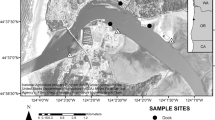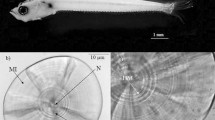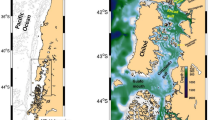Abstract
A field experiment was conducted for 4 consecutive days in December 2010 in Hornopirén inlet, a fjord from Chilean Patagonia, in order to determine the impact of marked environmental differences on fish larval distribution and growth (i.e., otolith microstructure) of the rockfish Sebastes oculatus. Two layers were noticeable: a surface one (0–10 m depth), characterized by warmer temperature and lower salinity, separated by a strong thermo- and halocline from the deep layer (>10 m depth), with lower temperature and saltier waters. As a prey field, nauplii showed similar abundances between strata, but calanoid copepodites were more abundant below the thermocline. Larval S. oculatus were more abundant in the deep stratum. Temperature was negatively correlated with calanoid copepodites as well as with S. oculatus abundances. Larval density was positively correlated with copepodites but not with nauplii abundance. S. oculatus larvae from the surface layer grew faster (0.137 ± 0.006 mm day−1) than those collected below the thermocline (0.103 ± 0.012 mm day−1). Otolith size (radius) as well as the recent otolith growth index was similar in individuals collected from both water parcels; however, linear mixed-effects models indicate that microincrement widths were slightly wider in older larvae occurring above the thermocline. Conclusions are that water temperature was more important than food availability for larval fish growth and recent hydrographic conditions are affecting the growth trajectories of larval rockfish in a Chilean fjord.






Similar content being viewed by others
References
Aguilera B, Catalán IA, Palomera I, Olivar MP (2009) Otolith growth of European seabass (Dicentrarchus labrax L.) larvae fed with constant or varying food levels. Sci Mar 73:173–182
Alemany F, Alvarez I, García A, Cortés D, Ramírez T, Quintanilla J, Alvarez F, Rodríguez JM (2006) Postflexion larvae and juvenile daily growth patterns of the Alboran Sea sardine (Sardina pilchardus Walb.): influence of wind. Sci Mar 70:93–104
Anderson JT (1994) Feeding ecology and condition of larval and pelagic juvenile redfish Sebastes spp. Mar Ecol Prog Ser 104:211–226
Bailey MC, Heath MR (2001) Spatial variability in the growth rate of blue whiting (Micromesistus poutassou) larvae at the shelf edge west of the UK. Fish Res 50:73–87
Bustos CA, Landaeta MF, Balbontín F (2008) Spawning and early nursery areas of anchoveta Engraulis ringens Jenyns, 1842 in fjords of southern Chile. Rev Biol Mar Oceanogr 43:381–389
Bustos CA, Landaeta MF, Balbontín F (2011) Ichthyoplankton spatial distribution and its relation with water column stratification in fjords of southern Chile (46°48′–50°09′S) in austral spring 1996 and 2008. Cont Shelf Res 31:293–303
Bustos CA, Landaeta MF, Palacios-Fuentes P, Jahnsen-Guzmán N, Balbontín F (2015) Comparing early life traits of hakes from Chilean Patagonian fjords inferred by otolith microstructure analysis. Fish Res 164:35–44
Cáceres M, Valle-Levinson A, Atkinson L (2003) Observations of cross-channel structure of flow in an energetic tidal channel. J Geophys Res 108(C4):3114:1–3114:10
Cameron RAD, Triantis KA, Parent CE, Guilhaumon F, Alonso MR, Ibáñez M, de Frias Martins AM, Ladle RJ, Whittaker RJ (2013) Snails on oceanic islands: testing the general dynamic model of oceanic island biogeography using linear mixed effect models. J Biogeogr 40:117–130. doi:10.1111/j.1365-2699.2012.02781.x
Castro LR, Cáceres MA, Silva N, Muñoz MI, León R, Landaeta MF, Soto-Mendoza S (2011) Short-term variations in mesozooplankton, ichthyoplankton, and nutrients associated with semi-diurnal tides in a Patagonian Gulf. Cont Shelf Res 31:282–292
Clemmesen C, Doan T (1996) Does otolith structure reflect the nutritional condition of a fish larva? Comparison of otolith structure and biochemical index (RNA/DNA ratio) determined on cod larvae. Mar Ecol Prog Ser 138:33–39
Dávila PM, Figueroa D, Müller E (2002) Freshwater input into the coastal ocean and its relation with the salinity distribution off austral Chile (35–55°S). Cont Shelf Res 22:521–534
Fiksen Ø, Jørgensen C (2011) Model of optimal behaviour in fish larvae predicts that food availability determines survival, but not growth. Mar Ecol Prog Ser 432:207–219
Kenchington TJ (1991) Vertical distribution and movements of larval redfishes (Sebastes spp.) in the Southern Gulf of St. Lawrence. J Northw Atl Fish Sci 11:43–49
Laidig TE, Ralston S, Bence JR (1991) Dynamics of growth in the early life history of the shortbelly rockfish, Sebastes jordani. Fish Bull 89:611–621
Laidig TE, Sakuma KM, Nishimoto MM (1996) Description of pelagic larval and juvenile stripetail rockfish, Sebastes saxicola (family Scorpaenidae) with an examination of larval growth. Fish Bull 94:289–299
Laidig TE, Sakuma KM, Hyde JR, Watson W, Lawley CT (2008) Identification, description, and daily growth of pelagic larval and juvenile squarespot rockfish, Sebastes hopkinsi (family Sebastidae). CalCOFI Rep 49:212–221
Landaeta MF, Castro LR (2006) Larval distribution and growth of the rockfish, Sebastes capensis (Sebastidae, Pisces), in the fjords of southern Chile. ICES J Mar Sci 63:714–724
Landaeta MF, López G, Suárez-Donoso N, Bustos CA, Balbontín F (2012) Larval fish distribution, growth and feeding in Patagonian fjords: potential effects of freshwater discharge. Environ Biol Fish 93:73–87
Landaeta MF, Martínez RA, Bustos CA, Castro LR (2013) Distribution of microplankton and fish larvae related to sharp clines in a Patagonian fjord. Rev Biol Mar Oceanogr 48:401–407
Landaeta MF, Ochoa-Muñoz MJ, Bustos CA (2014) Feeding success and selectivity of larval anchoveta Engraulis ringens in a fjord-type inlet from northern Patagonia (Southeast Pacific). Rev Biol Mar Oceanogr 49(3):461–475
Landaeta MF, Bustos CA, Contreras JE, Salas-Berríos F, Palacios-Fuentes P, Alvarado-Niño M, Letelier J, Balbontín F (2015) Larval fish feeding ecology, growth and mortality from two basins with contrasting environmental conditions of an inner sea of northern Patagonia, Chile. Mar Environ Res 106:19–29
Lee T-W, Kim G-C (2000) Microstructural growth in otoliths of black rockfish, Sebastes schlegeli, from prenatal larval to early juvenile stages. Ichthyol Res 47:335–341
Leis JM, Caselle JE, Bradbury IR, Kristiansen T, Llopiz JK, Miller MJ, O’Connor MI, Paris CB, Shanks AL, Sogard SM, Swearer SE, Treml EA, Vetter RD, Warner RR (2013) Does fish larval dispersal differ between high and low latitudes? Proc R Soc B 280:20130327
León R, Castro LR, Cáceres M (2008) Dispersal of Munida gregaria (Decapoda: Galatheidae) larvae in Patagonian channels of southern Chile. ICES J Mar Sci 65:1131–1143
Love MS, Brothers E, Schroeder DM, Lenarz WH (2007) Ecological performance of young-of-the-year blue rockfish (Sebastes mystinus) associated with oil platforms and natural reefs in California as measured by daily growth rates. Bull Mar Sci 80:147–157
Meekan MG, Carleton JH, McKinnon AD, Flynn K, Furnas M (2003) What determines the growth of tropical reef fish larvae in the plankton: food or temperature? Mar Ecol Prog Ser 256:193–204
Meerhoff E, Tapia FJ, Sobarzo M, Castro L (2015) Influence of estuarine and secondary circulation on crustacean larval fluxes: a case study from a Patagonian fjord. J Plankt Res. doi:10.1093/plankt/fbu106
Molinet C, Lafón A, Lembeye G, Moreno CA (2003) Patrones de distribución espacial y temporal de floraciones de Alexandrium catenella (Whedon & Kofoid) Balech 1985, en aguas interiores de la Patagonia noroccidental de Chile. Rev Chil Hist Nat 76:681–698
Molinet C, Niklitschek E, Moreno CA, Arévalo A (2008) Vertical distribution of early and competent larvae of Concholepas concholepas in two systems of Chilean inland seas. Mar Biol 153:779–787
Nagasawa T, Domon K (1997) The early life history of kurosoi, Sebastes schlegeli (Scorpaenidae), in the Sea of Japan. Ichthyol Res 44:237–248
Palacios-Fuentes P, Landaeta MF, Muñoz G, Plaza G, Ojeda FP (2012) The effects of a parasitic copepod on the recent larval growth of a fish inhabiting rocky coasts. Parasitol Res 111:1661–1671
Palma S, Silva N (2004) Distribution of siphonophores, chaetognaths, euphausiids and oceanographic conditions in the fjords and channels of southern Chile. Deep Sea Res II 51:513–535
Plaza G, Katayama S, Omori M (2003) Timing of parturition, planktonic duration, and settlement patterns of the black rockfish, Sebastes inermis. Environ Biol Fish 68:229–239
R Development Core Team (2013) R: A language and environment for statistical computing. R Foundation for Statistical Computing, Vienna, Austria. ISBN 3-900051-07-0. http://www.R-project.org
Reiss CT, Anis A, Taggart CT, Dower JF, Ruddick B (2002) Relationships among vertically structured in situ measures of turbulence, larval fish abundance and feeding success and copepods on Western Bank, Scotian Shelf. Fish Oceanogr 11:156–174
Sabatés A, Olivar MP (1990) Early development and spawning of Sebastes capensis in the Southeast Atlantic. Mar Biol 107:389–395
Sakuma KM, Laidig TE (1995) Description of larval and pelagic juvenile chilipepper, Sebastes goodie (family Scorpaenidae), with an examination of larval growth. Fish Bull 93:721–731
Sakuma KM, Ralston S, Roberts DA (1999) Diel vertical distribution of postflexion larval Citharichthys spp. and Sebastes spp. off central California. Fish Oceanogr 8:68–76
Shanks AL, Brink L (2005) Upwelling, downwelling, and cross-shelf transport of bivalve larvae: test of a hypothesis. Mar Ecol Progr Ser 302:1–12
Sponaugle S, Cowen RK, Shanks A, Morgan SG, Leis JM, Pineda J, Boehlert GW, Kingsford MJ, Lindeman KC, Grimes C, Munro JL (2002) Predicting self-recruitment in marine populations: biophysical correlates and mechanisms. Bull Mar Sci 70:341–375
Sumida BY, Moser HG (1984) Food and feeding of bocaccio (Sebastes paucispinis) and comparison with Pacific hake (Merluccius productus) larvae in the California Current. CalCOFI Rep 25:112–118
Takasuka A, Aoki I (2006) Environmental determinants of growth rates for larval Japanese anchovy Engraulis japonicus in different waters. Fish Oceanogr 15:139–149
Valle-Levinson A, Sankar N, Sanay R, Soto D, León J (2007) Spatial structure of hydrography in a flow of a Chilean fjord, Estuario Reloncaví. Estuar Coasts 30:113–126
Woodson CB, McManus MA (2007) Foraging behavior can influence dispersal of marine organisms. Limnol Oceanogr 52:2701–2709
Zenteno JI, Bustos CA, Landaeta MF (2014) Larval growth, condition and fluctuating asymmetry in the otoliths of a mesopelagic fish in an area influenced by a large Patagonian glacier. Mar Biol Res 10:504–514
Acknowledgments
The authors want to thank Cristian Cortez, Nicolás Suárez-Donoso, Franco Salas-Berríos and María J. Ochoa-Muñoz (Universidad de Valparaíso) for assistance with the field work and Paulina Contreras for assistance with the laboratory work (Universidad de Concepción). We also appreciate the comments of two anonymous reviewers. This research was supported by project FONDECYT under grant no. 11090020, adjudicated to MFL.
Author information
Authors and Affiliations
Corresponding author
Additional information
Handling Editor: Thomas Mehner.
Appendix
Appendix
Details and formalities of the linear mixed model framework presented for better understanding of the present study.
Formally, the linear mixed model of the present experiment is summarized as:
where y ij is the observed response of the growth measured as an increment band width of the otolith of a particular individual fish for observation j (depth) on a different individual i; X ij is the experimental field treatment (including two depth levels), consisting of columns representing factor contrasts and covariates. β represents the mean population coefficient of the larvae at different stages (ages) at different depth strata. b i is a random variable representing the deviation from the population mean abundance for the ith day (age of each larval fish), and ɛ ij is a random variable representing the deviation in abundance for observation of j on day i from the mean increment width for day i.
To complete the statistical model we specify the distribution of the random variables, b i , i = 1,…, M (random variables, age in days in this study, 27 days for larval fish at 0–10 m depth and 25 days for larval fish from 10 to 45 m depth) and ɛ ij , i = 1,…, M; j = 1, …, n i (levels of the two main depth). We modeled both (random variables from the observations of each treatments) as independent, constant variance and with a mean of zero. The variances are denoted by σ 2 b for the b i or “between-age or day” variability, and σ 2 for the ɛ ij , or “within-age or day” variability. This is summarized in (2).
Rights and permissions
About this article
Cite this article
Landaeta, M.F., Contreras, J.E., Bustos, C.A. et al. Growth and condition of larval rockfish in a Patagonian fjord-type inlet: role of hydrographic conditions and food availability. Aquat Ecol 49, 573–584 (2015). https://doi.org/10.1007/s10452-015-9547-y
Received:
Accepted:
Published:
Issue Date:
DOI: https://doi.org/10.1007/s10452-015-9547-y




